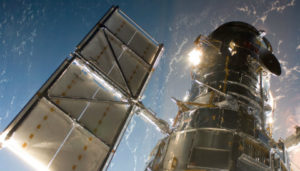Following three weeks of downtime, engineers have cleared out a mechanical blockage in one of Hubble's gyroscopes and returned the observatory to full science operations.

NASA, ESA
After a three-week hiatus, the Hubble Space Telescope is back in business.
The observatory had been hibernating since October 6th, after a backup gyroscope started behaving abnormally. After working out the kinks in this behavior late last week, the Hubble operations team returned the venerable telescope back to full science operation late on Friday.
The 28-year-old space telescope completed its first science observation on October 27th at 2:10 a.m. EDT — its target was a remote star-forming galaxy designated DSF2237B-1-IR.
Hubble’s gyroscopes are a key element of the telescope’s pointing control system, a collection of components that determine where the telescope is pointing at any given time. This info is vital for ensuring that the observatory stays on target and knows how to shift its gaze from one celestial body to another.
Normally, Hubble uses three gyroscopes to measure the telescope’s rotation rate in three dimensions of space. On October 5th, one of the gyroscopes stopped working. The observatory switched to its last remaining backup the following day, but the replacement reported rotation rates that far exceeded what the telescope was actually doing. Hubble put itself in safe mode, a safety feature in which the telescope suspends science observations and awaits instructions from its support crew back on Earth.
“We think the spinning of the gyroscope was likely affected by an inconsistency in the surrounding fluid or material,” says Tom Brown (Space Telescope Science Institute), head of the Hubble mission office. He says that because the gyroscope had been sitting inactive for several years, it may have developed an air bubble in its fluid or a stiff wire in one of its power leads. The team tried switching between operational states, which helped a bit, as well as simply turning the gyro’s power off and on, which didn’t do anything.
“The next thing we could do in the realm of benign actions was to perform maneuvers while toggling the operational state,” he says. The team commanded Hubble to go through a series of turns, hoping to reset the gyro — and it worked. With the anomaly cleared, the team put the gyro through its paces by pointing the observatory at a number of test targets while also uploading additional software safeguards, just in case.
Now it’s back to business as usual.
“The science instruments are all in good shape, and scientists are using them in clever ways to learn new details about the solar system, exoplanets, and even the expansion history of the universe,” says Jennifer Wiseman (NASA Goddard Space Flight Center). “We are hopeful that Hubble will overlap with the James Webb Space Telescope, to be launched in 2021, by several years into the 2020s.”
 0
0









Comments
You must be logged in to post a comment.